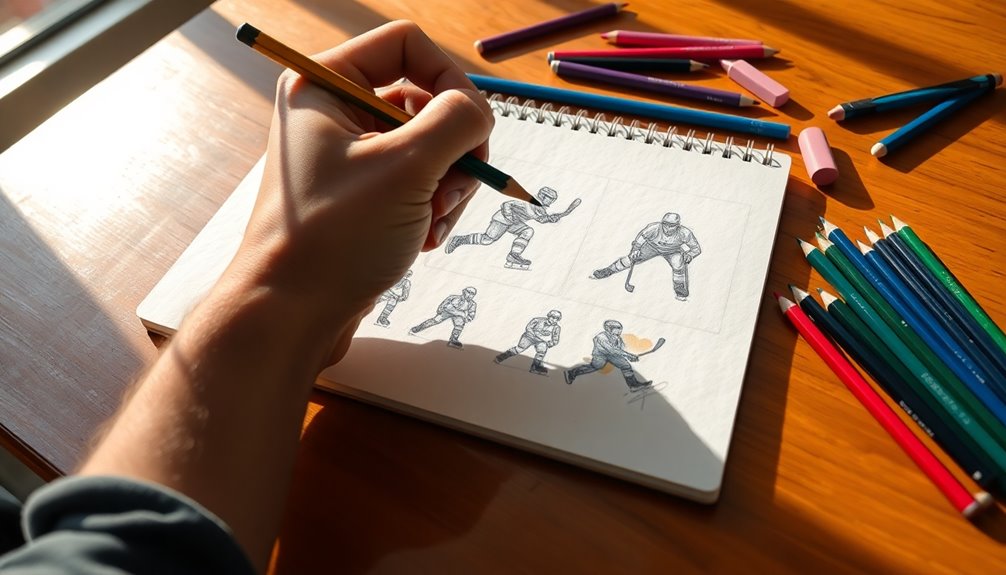
Step-by-Step Guide: How to Draw a Hockey Player
January 2, 2025To draw a hockey player, start by mastering basic proportions and shapes. Use a pencil and eraser for initial sketches, focusing on the core anatomy, like shoulder pads and helmet. Next, sketch the arms and legs, using dynamic poses for energy. Incorporate facial features and add helmet details. When you're ready, switch to color, using team shades for authenticity. Don't hesitate to personalize your player with custom logos or colors. Finally, refine your work with final touches for realism. Keep going, and you'll uncover more tips to enhance your drawing skills.
Drawing Basics and Techniques
When you're diving into the world of drawing, mastering the basics and techniques is vital for creating a compelling hockey player illustration. Start by familiarizing yourself with drawing basics, like understanding proportions and shapes. This foundational knowledge will make it easier to depict a hockey player accurately. Additionally, comprehending basic rules of sports can enhance your understanding of player dynamics and movement. Soccer, for example, has specific field dimensions that can influence how players are portrayed in action.
Utilizing step-by-step instructions can really help you break down the drawing process. Follow each step carefully, pausing the video lessons as needed to guarantee you grasp each part before moving on. This approach allows you to work at your own pace, making the learning process more enjoyable and effective.
As you're practicing, remember that important tools like a marker and paper are essential for bringing your hockey player to life. These tools will enable you to express your creativity and refine your technique.
Don't forget to add detailing, such as wrinkles in the clothing and stripes on the shorts, to enhance the realism of your illustration. Additionally, consistent practice is crucial for refining skills and developing your unique drawing style.
Essential Drawing Tools
Having the right tools is essential for successfully drawing a hockey player. Start with basic drawing tools like a pencil and paper for outlining your artwork. A good eraser is vital, as it allows you to correct any mistakes that might pop up during the process. Additionally, incorporating dynamic exercises into your warm-up can enhance your focus and coordination while drawing. Engaging in agility drills can also help improve your hand-eye coordination, which is beneficial for detailed artwork.
Don't underestimate the power of a ruler; it's particularly useful for creating straight lines, especially when you're sketching the hockey stick. Once you've got your outline, consider adding some color. Colored pencils or markers will enable you to bring vibrant team colors to life and personalize your hockey player's uniform. This step can really make your drawing stand out.
Additionally, having reference images of hockey players nearby can be incredibly helpful. These images serve as inspiration and guide you in capturing the details important to a realistic portrayal. To enhance your drawing experience, consider checking for exclusive discounts on art supplies that may be available through coupon codes. Keep your reference handy as you work, allowing you to check for accuracy in posture, equipment, and overall style. With these important drawing tools, you're well-equipped to create an impressive depiction of a hockey player that showcases your artistic skills.
Understanding Hockey Player Anatomy
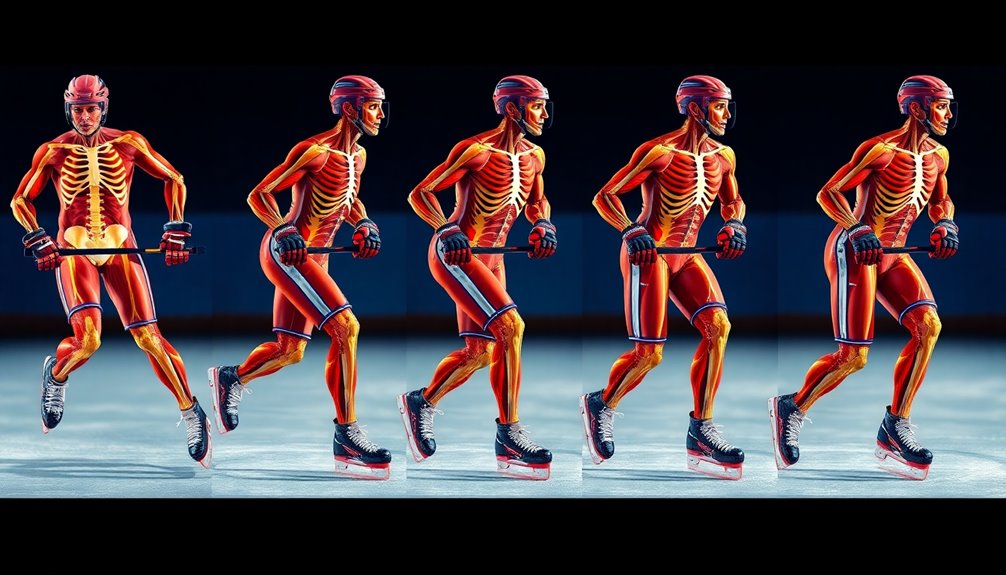
Understanding the anatomy of a hockey player is essential for capturing their dynamic pose and equipment accurately. Start by sketching the core structure, focusing on the upper body. The shoulder pads are a key element, giving bulk and protection, so make sure to depict them prominently. Additionally, understanding the importance of physical fitness can help you appreciate the player's agility and strength during play.
Next, let's go to the head. Draw a U-shape for the helmet, adding design elements like ear holes and straps. For the face, create facial features, paying attention to the forehead, nose, chin, and adding expressive details like the eyes and mouth.
When it comes to the arms, draw them with a sideways V shape for the elbows. Use rectangles combined with U-shapes to form the gloves and fingers, ensuring they look realistic.
For the legs, position the left leg diagonally for perspective, while the right leg should be an upside-down U-shape to show a bend at the knee.
Finally, incorporate the skates. Use a U-shape for the body and a V-shape for the blades, adding shoelaces and striped socks for added realism. Additionally, understanding key regulations can enhance your enjoyment of the sport and provide context to your illustration.
With these details in mind, I'm going to help you create an impressive hockey player illustration!
Sketching the Helmet
Now that you've got the anatomy of a hockey player down, let's focus on sketching the helmet. Start by drawing a U-shape to create the basic outline, ensuring it has a rounded top and a protective front. This forms the foundation of your helmet design concepts.
Next, add ear holes on each side for realism, indicating where the player's ears would sit.
To enhance the protective features analysis, incorporate a strap design connecting the front to the back. Draw a rectangle shape for the chin strap, which adds functionality and detail. A helmet's design should prioritize protective features to ensure player safety. The importance of commitment and perseverance in training also applies to the development of equipment that keeps players safe on the ice.
For added realism, sketch squares or other shapes on the sides to represent ventilation or customization techniques that many helmets feature.
Finally, refine the helmet's shape and lines, ensuring it looks proportionate to the player's head. Pay attention to the curves and angles to achieve a sleek, authentic look. Additionally, consider how the helmet's design can impact the player's comfort and performance on the ice.
This step is essential for conveying the helmet's protective nature while also allowing for individual expression through unique designs. With these details in place, you'll have a solid representation of a hockey helmet ready for your player.
Adding Facial Features
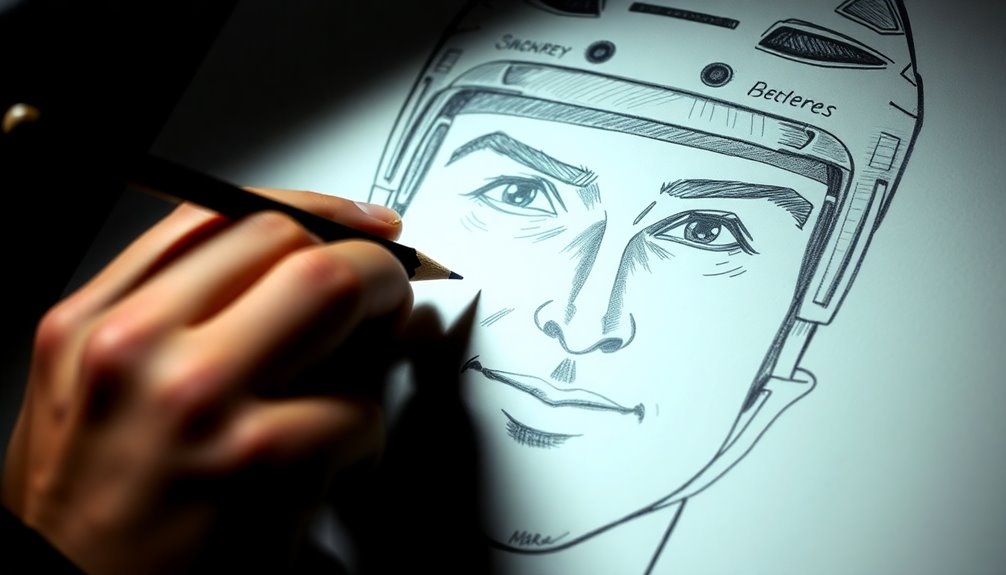
To bring your hockey player to life, start by sketching the facial features within the helmet. Begin with the forehead, nose, and chin to establish the basic facial structure. Use small, rounded shapes for the eyes, placing them symmetrically on either side of the nose. This symmetry helps in portraying a balanced character mood representation. Teamwork is key in soccer as it is in hockey, as both sports rely heavily on collaborative effort to achieve success. Additionally, mental toughness is essential for athletes to maintain focus during intense moments and challenges on the ice.
Next, add a simple curved line for the mouth below the nose, adjusting its shape to reflect your player's emotion—this is where your facial expression techniques come into play. A straight line might indicate focus, while a slight curve can show determination.
Don't forget about the helmet design styles; include an ear hole and a strap to anchor the facial features realistically. These details not only add authenticity but also enhance the overall look.
Finally, refine the details around the eyes and mouth to intensify the character's expression, capturing the essence of the game. Remember, the way you depict these features can convey a lot about your player's personality and emotions, making your drawing truly come alive. Teamwork and collaboration are essential elements in both hockey and art, as they foster creativity and enhance the collective experience.
Arms and Hockey Stick
When drawing a hockey player, you'll want to pay close attention to the positioning of the arms and the design of the hockey stick.
Start by shaping the arms in dynamic poses, as this will showcase the player's action and energy. Additionally, consider how the player's arms interact with the hockey stick to enhance their scoring opportunities during gameplay, bringing your drawing to life. Then, focus on creating a realistic hockey stick that complements those arm movements, bringing your drawing to life.
Arm Positioning Techniques
Capturing the dynamic arm positioning of a hockey player is essential for a realistic drawing. Start by sketching the left arm in a sideways V shape at the elbow, ensuring it appears bent to reflect natural stance and movement fluidity. For the glove, use a rectangle for the wrist and a U-shape for the fingers, which will create a realistic gesture of the hand.
Next, focus on the right arm gripping the hockey stick. Draw the stick extending downward with straight lines, emphasizing the grip to showcase arm dynamics. This positioning not only anchors the player but also adds authenticity to the action.
As you detail the arms, incorporate sleeve details using curved lines and wrinkles. These elements enhance realism and suggest movement, making your drawing feel alive.
Hockey Stick Design
Designing a hockey stick requires attention to both its shape and function, as it plays an essential role in a player's performance. Start by sketching the stick extending down from the player's hands, ensuring straight lines that reflect the grip and body position. Use proportions wisely so that the arms appear balanced with the stick.
For the right arm, draw a sideways V-shape to represent the elbow, giving it a natural, dynamic look. Don't forget the glove; create a rectangular base with a U-shape for the fingers, adding details to capture its structure. Incorporate sleeve details with wrinkles to enhance realism and motion.
Choosing the right hockey stick materials is vital for performance; options include wood, composite, or aluminum. Each material has its own feel and weight. Consider stick curve options, as they can affect puck handling and shooting accuracy.
Finally, apply grip tape to the handle for better control and comfort. This not only improves the player's grip but also adds a personal touch to the stick's design. By carefully crafting these elements, your hockey player will look ready to take on the ice.
Detailing the Jersey
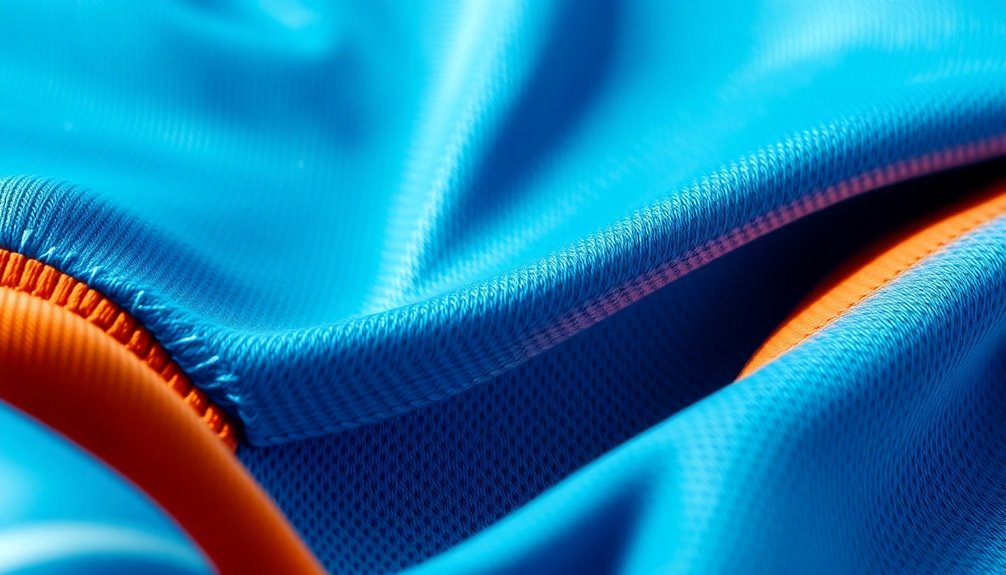
To make your jersey stand out, start by adding stripes that capture attention and enhance the design.
Don't forget to place the team logo prominently, as it adds authenticity to your drawing.
Finally, choose colors that reflect the team's identity and balance them for a cohesive look.
Team Logo Placement
When it comes to placing the team logo on a hockey jersey, positioning it prominently on the chest area is key for visibility. A well-placed logo not only enhances team logo visibility but also adds personality to your design.
Make certain the logo is proportional to the jersey—typically, it should occupy about 5-10 inches wide.
For maximum effect, consider the following:
- Choose vibrant colors for the logo that contrast well with the jersey's base color.
- Position a smaller logo on the shoulder or sleeve for added flair.
- Incorporate your favorite player's number alongside the team logo for a personalized touch.
- Confirm the logo design aligns with your team's brand identity.
- Remember that a well-placed logo boosts team spirit and pride among fans!
Color and Stripes
Adding color and stripes to the hockey jersey is essential for creating visual appeal and authenticity. Start by incorporating stripe patterns that not only add visual interest but also enhance the overall jersey design.
Think about the color combinations that reflect your team's colors, like red and blue, to achieve a classic look. This connects to color psychology, as these colors can evoke feelings of energy and excitement.
When detailing the jersey, pay attention to the placement of stripes and any logos; these small details can greatly elevate the realism of your drawing. You might also consider personalizing the jersey by adding your favorite player's number, giving it that unique touch.
As you move into the coloring process, take your time to guarantee even application and vibrant colors. Remember, the final look hinges on how well you execute this step.
Use high-quality materials to achieve the best results, and don't shy away from experimenting with different shades or textures. This way, you'll create a hockey jersey that not only stands out but also resonates with the spirit of the game.
Drawing the Legs
Creating a dynamic pose for your hockey player starts with drawing the legs. Focus on leg proportions to guarantee they look realistic and powerful. For the left leg, draw it diagonally, using curves to define its shape and position, adding a sense of perspective. The right leg should take an upside-down U-shape to indicate bending, showcasing the player's athletic stance.
To enhance your drawing, remember to incorporate details that evoke emotion:
- Stripes on the socks for a professional look
- Curves in the legs to emphasize movement
- Directional wrinkles to show the natural folds of clothing
- Cohesive shoelace detailing for consistency
- Dynamic poses that capture the excitement of the game
These elements help create a vivid image of your hockey player in action. By incorporating clothing folds and emphasizing movement, you'll bring your drawing to life.
Keep refining the details, and soon, you'll have legs that not only look strong but also convey the energy of the sport.
Designing the Skates
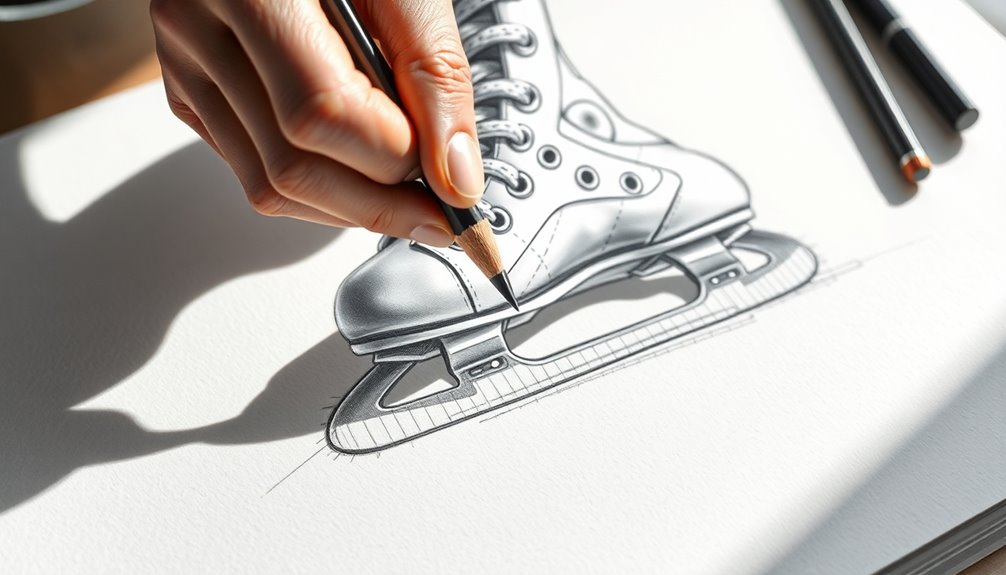
When you start designing the skates, create a U-shape for the boot to form the base structure.
Then, add a V-shape at the bottom to represent the blade, making sure it captures the right angle for skating.
Finally, illustrate shoelaces with small, curved lines across the top for a realistic touch.
Skate Shape and Structure
To design the skates for your hockey player, start with a U-shape that forms the base of the boot. This shape gives the skates their essential structure.
Next, incorporate a V-shape for the blades to provide that characteristic cutting edge on the ice.
As you illustrate, remember to add shoelaces across the top of the skates for added realism.
Consider how your choice of colors can inspire skate design inspiration. Think about blade material choices that enhance performance and aesthetics.
Complement the skates with sock color combinations that can elevate the overall look. Here are some ideas to evoke emotion and creativity:
- Bold stripes that catch the eye
- Classic colors that evoke nostalgia
- Unique patterns that show personality
- Bright shades for a striking contrast
- Subtle hues for a more sophisticated feel
Lastly, verify the right leg is drawn in an upside-down U-shape to depict the bending motion while skating. This detail captures the dynamic essence of a hockey player in action and brings your drawing to life!
Detailing Shoelaces and Blades
After establishing the shape and structure of the skates, it's time to focus on detailing the shoelaces and blades. Start by drawing a U-shape for the top of the skate, making sure it's proportional to the player's foot. For the skate blade, create a V-shape at the bottom of the U-shape; this will represent the blade's edge effectively.
Next, illustrate the shoelaces using small, evenly spaced vertical lines across the top of the skate, connecting them to the eyelets. This lace technique not only enhances your skate design but also adds realism to your drawing.
Don't forget to include the tongue of the skate, depicted as a small rectangle just above the laces. To further enhance the realism, add curved lines along the skate's body. This detail will indicate its structure and depth, giving it a three-dimensional appearance.
You can also hint at blade materials by shading lightly along the blade edge, suggesting the metal's reflective quality. With these details, your skates will look dynamic and ready for action on the ice!
Customizing the Jersey
Customizing the jersey adds a personal touch to your hockey player drawing, making it truly stand out. Start by incorporating some jersey personalization techniques that reflect your unique style. Consider these elements to enhance your design:
- Add your favorite team's logo for a personal connection.
- Incorporate a number on the back that represents your hockey player inspiration.
- Use stripes on the sleeves and bottom to create visual interest.
- Focus on fabric texture enhancement with details like wrinkles and stitching.
- Experiment with colors that resonate with you or your team's identity.
These small adjustments can elevate your drawing from ordinary to extraordinary.
Remember, the jersey is a canvas for your creativity. When you take the time to customize the jersey, you're not just drawing a hockey player; you're telling a story. Each detail you choose adds depth and character, making your artwork feel alive.
Embrace your passion for the game, and let it shine through in your design. With these tips, you'll create a hockey player that's not only visually appealing but also a true reflection of your love for the sport.
Color Selection Tips
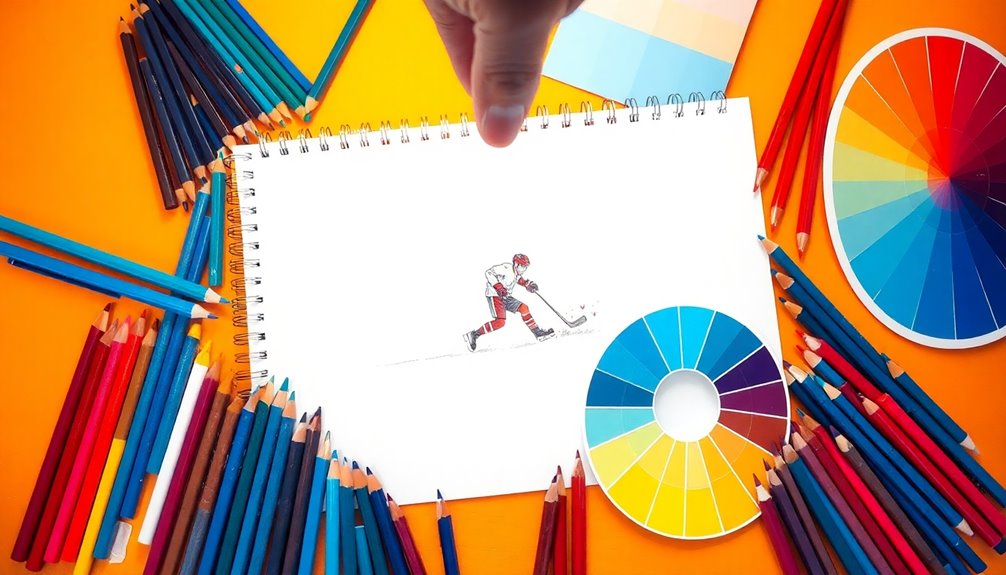
When picking colors for your hockey player, think about using team colors to boost authenticity and spirit.
Don't shy away from adding your personal touch with unique shades that reflect your style.
Also, use highlights to emphasize key features, making your drawing more dynamic and engaging.
Team Color Coordination
How can you make your hockey player drawing really pop? Team color coordination is essential to capturing that vibrant energy and team spirit. By choosing colors that reflect your favorite team's scheme, you can create a cohesive look that resonates with fans.
Here are some tips to enhance your design:
- Use contrasting colors for the jersey and shorts to grab attention.
- Incorporate accents like stripes or logos in team colors for authenticity.
- Experiment with different shades of the same color to add depth, especially in the jersey and skates.
- Consider color psychology; certain colors evoke emotions, so choose hues that reflect your team's identity.
- Keep up with design trends; vibrant and bold choices are popular for sports art.
Personal Color Preferences
Selecting colors for your hockey player drawing can be a fun and personal experience that reflects your unique style. Start by considering color symbolism; for example, red and blue are popular choices associated with team colors, enhancing visibility and energy.
You can personalize your jersey design by adding your favorite player's number and team logo, making your artwork truly one-of-a-kind.
Experiment with different color combinations for the jersey, gloves, and shorts. This not only creates a visually appealing contrast but also showcases your creativity.
Don't hesitate to explore unconventional colors that resonate with you—this is your chance to express yourself!
Consider using black for the hockey stick end to simulate tape; it adds a realistic touch to your drawing.
As you choose your colors, think about what inspires you. Whether it's a specific player or a memorable game, let that player inspiration guide your decisions.
Highlighting Key Features
What colors will make your hockey player drawing stand out? The right color choices can elevate your artwork and capture the dynamic hockey player expressions.
Consider using team colors, like red and blue, for an authentic jersey design inspiration. These bold hues will grab attention and add depth to your piece.
Here are some tips to enhance your drawing:
- Use black at the end of the hockey stick to simulate tape, adding realism.
- Explore personal color choices for the jersey and helmet—reflect your favorite player's style.
- Incorporate stripes on the jersey and socks for visual interest.
- Choose colors that evoke emotion, making viewers feel the energy of the game.
- Experiment with shades to highlight stick handling techniques, showcasing agility.
Applying Color to Your Drawing
Bring your hockey player to life by carefully applying color to your drawing. Start with the hockey stick, using black to simulate tape at the end for a realistic touch.
Next, choose vibrant colors for the jersey—red and blue are popular team colors, but feel free to explore personal choices that reflect your style. Incorporate color mixing techniques to create different shades that add depth to the jersey and shorts. Use lighter and darker tones to showcase the folds and movement.
Don't forget to add stripes for visual interest; this enhances the overall appeal of your drawing. Move on to the skates, ensuring you add color to the details, like the shoelaces, to make them pop.
As you finalize your piece, color the helmet and include small details like the team logo or the player's number. Understanding color theory basics can help you choose complementary colors that enhance your drawing's authenticity.
Emphasizing Creative Freedom
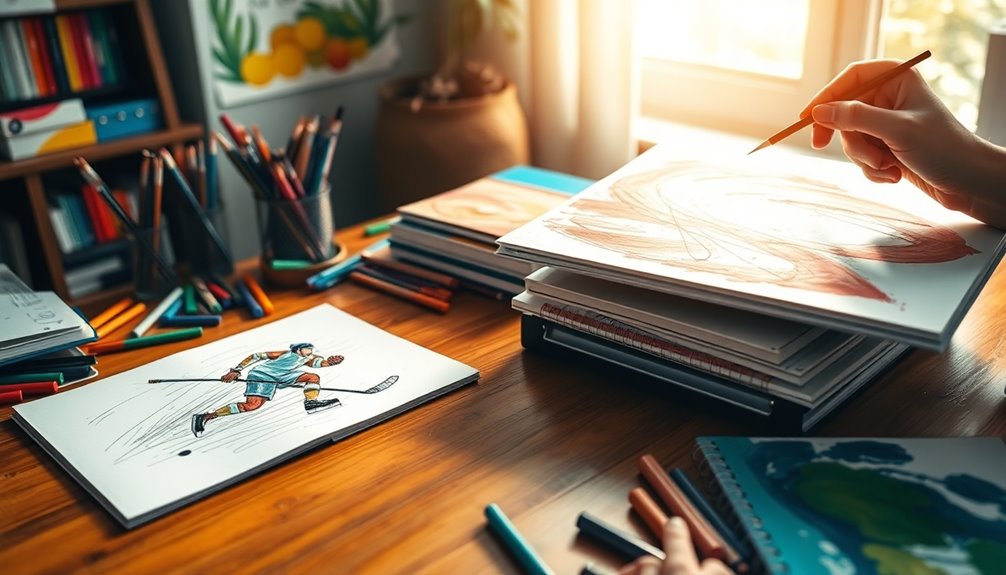
Embracing your creative freedom allows you to truly make your hockey player drawing your own. Immerse yourself in artistic inspiration and let your imagination run wild. Modify your hockey player's features, equipment, and jersey design to reflect your personal expression.
Remember, there's no need to stick to traditional team colors; experiment with vibrant hues and unique patterns!
Here are some ways to enhance your creative exploration:
- Personalize your jersey with a custom logo or unique number.
- Incorporate unexpected colors for the helmet and pads.
- Alter the player's stance or facial expression to convey emotion.
- Add accessories, like a special pair of skates or gloves.
- Transform the background into a scene that inspires you.
Enjoy the process without stressing over accuracy. Artistic expression thrives when you allow yourself the freedom to play, explore, and create.
Let your drawing be a reflection of your style and interests, rather than a perfect replica of reality. Embrace the joy of art and watch your hockey player come to life in ways you never imagined!
Adding Final Touches
As you approach the final stages of your hockey player drawing, consider how the little details can make a big difference in bringing your artwork to life. Start by adding team logos and your favorite player's numbers to the jersey for a personalized touch. This not only enhances authenticity but also reflects your personal style.
Next, incorporate small details like stripes on the jersey and socks. These elements add visual interest and depth that draw the viewer's eye. Use curved lines to define the sleeves and create wrinkles in the clothing, employing texture techniques that give a realistic appearance.
When it comes to color blending, think carefully about your color choices. For example, use black for the end of the hockey stick to simulate tape, and pick team colors for the jersey to make it pop.
Finally, don't forget to finish with detailing on the helmet. Adjust any elements as needed to elevate the overall quality of your drawing. These final touches won't only enhance your artwork but also showcase your dedication to capturing the essence of the sport.
Enjoying the Drawing Process
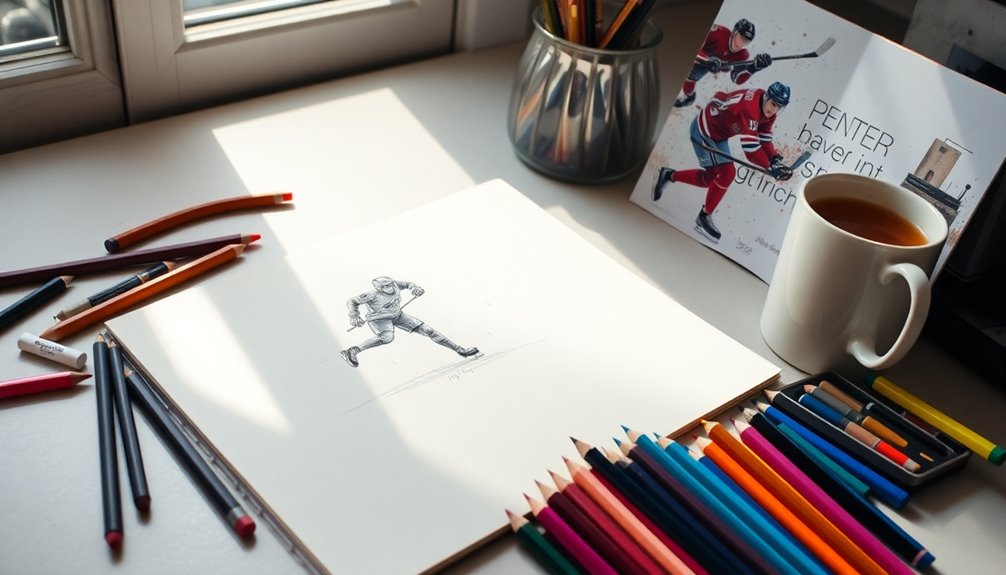
Drawing a hockey player should be a fun and fulfilling experience, so don't stress about achieving perfection. Embrace the joy of creative exploration as you let your playful imagination run wild. Remember, art is about expressing yourself, so wiggle your pencil freely and allow for joyful experimentation.
Here are some ways to enhance your drawing experience:
- Customize jerseys and helmets to reflect your personal style.
- Take breaks to prevent frustration and gain fresh perspectives.
- Explore different techniques and let your creativity flow.
- Focus on the process rather than the end result.
- Enjoy the little quirks that make your drawing unique.
Every stroke is a chance to express your individuality, so don't shy away from making bold choices. If something doesn't feel right, feel free to modify it; each change adds to your connection with the artwork.
Conclusion
Now that you've learned how to draw a hockey player, imagine the thrill of capturing that dynamic energy on paper. With your unique style and techniques, you can bring your vision to life. So, what will your hockey player look like as they glide across the ice, stick in hand, ready to score? Embrace your creativity, enjoy the process, and remember that each stroke brings you closer to mastering your art. Keep drawing and have fun!


